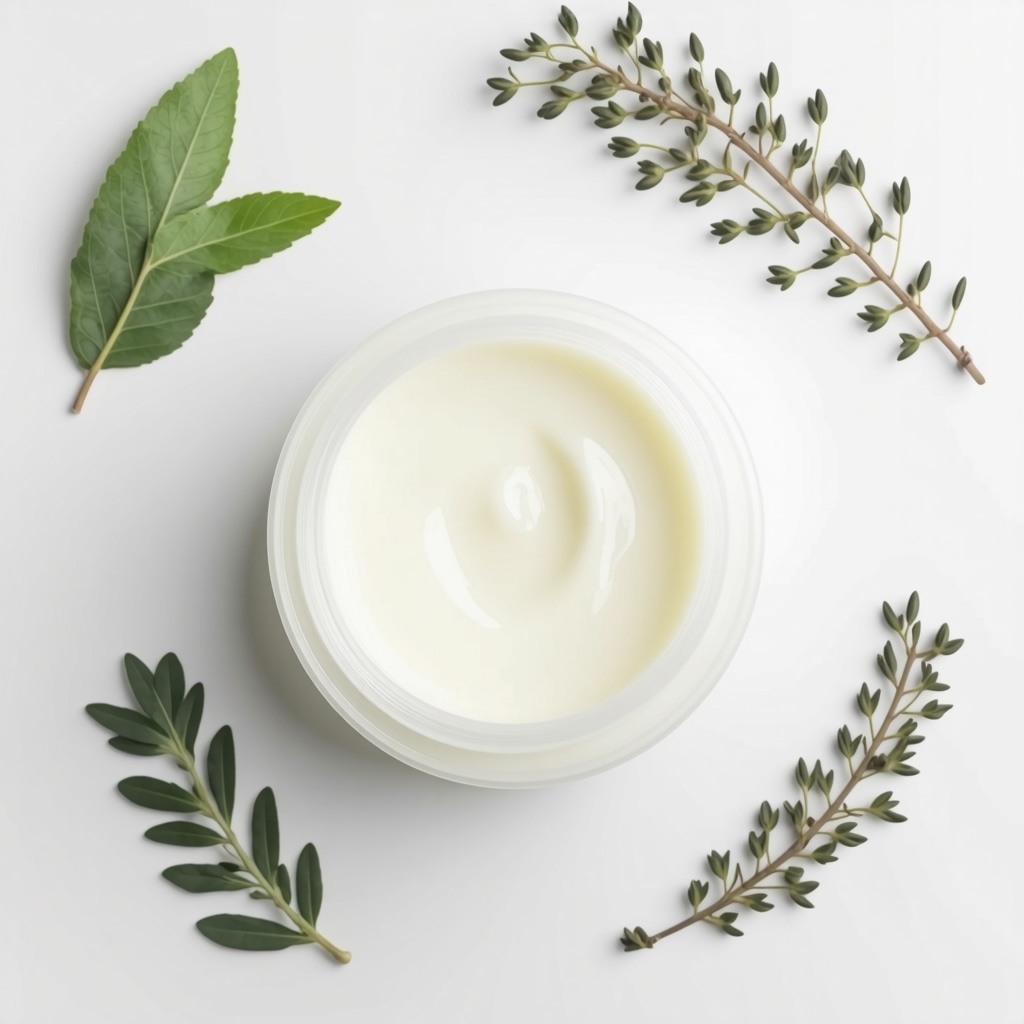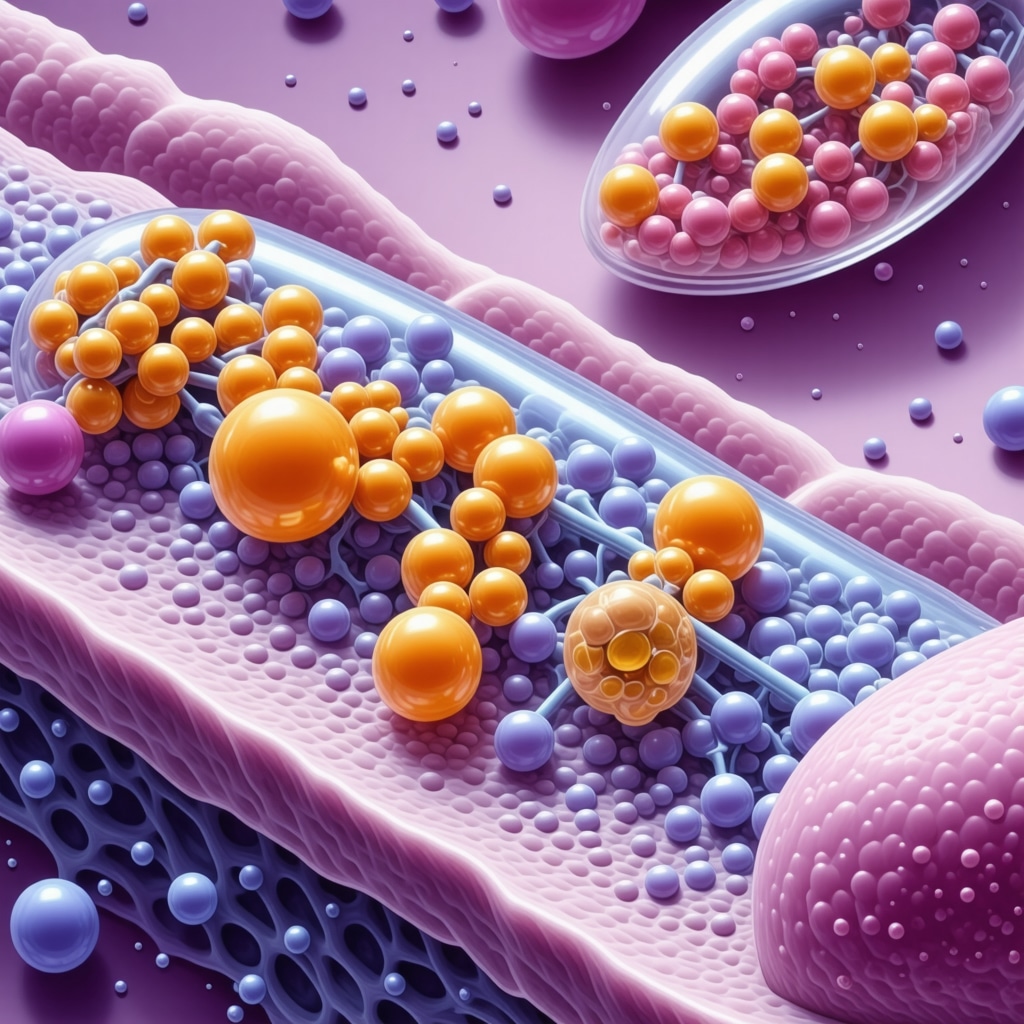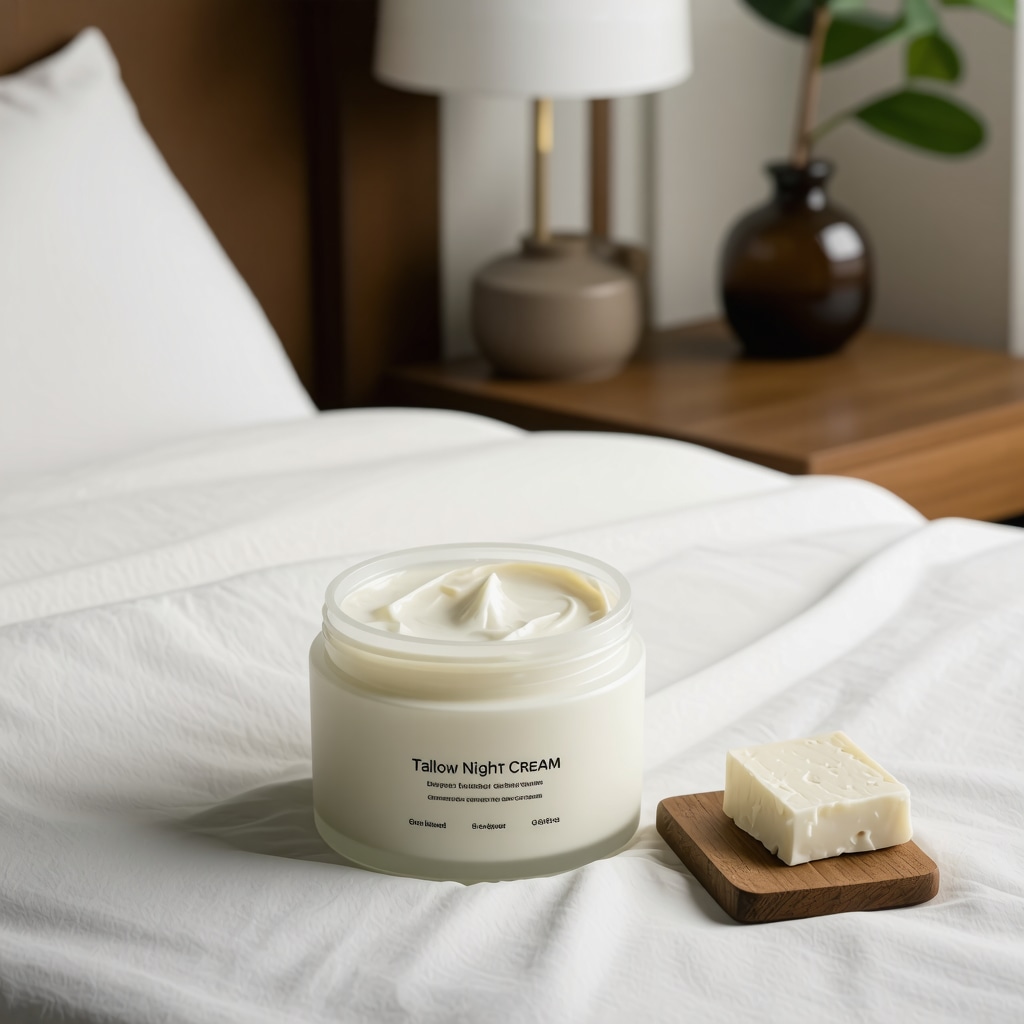The Renaissance of Tallow in Nighttime Skincare: A Scientific Perspective
In 2024, the resurgence of tallow-based night creams signals a paradigm shift in dermal nourishment, emphasizing bioidentical lipids and sustainable sourcing. Unlike conventional moisturizers laden with synthetic ingredients, premium tallow creams harness the complex fatty acid profiles intrinsic to grass-fed beef tallow, closely mimicking human sebum. This biochemical congruence facilitates superior skin barrier restoration and profound hydration during nocturnal regeneration cycles, positioning tallow creams as a formidable agent in advanced skincare regimens.
Biochemical Mechanisms Underpinning Tallow’s Hydrating and Reparative Properties
The efficacy of tallow night creams derives from their rich concentration of stearic, oleic, and palmitic acids, which orchestrate lipid bilayer reinforcement and occlusive hydration. These fatty acids not only replenish the stratum corneum’s lipid matrix but also exhibit anti-inflammatory and antimicrobial properties, promoting epidermal homeostasis. This lipid synergy accelerates transepidermal water loss (TEWL) reduction and facilitates repair processes, crucial for addressing dry, compromised skin often exacerbated by environmental stressors.
How Does Grass-Fed Organic Tallow Outperform Conventional Moisturizers in Sensitive Skin Repair?
Grass-fed organic tallow is distinguished by its higher antioxidant content and absence of pro-inflammatory seed oils commonly found in many lotions. This composition reduces the risk of irritation and allergic reactions, making it particularly efficacious for sensitive and eczema-prone skin types. Moreover, its natural vitamin A analogs and conjugated linoleic acid contribute to collagen synthesis stimulation and cellular turnover, enhancing skin texture and resilience overnight. For a detailed comparative analysis, see our comprehensive review on tallow versus shea butter for sensitive skin.
Formulation Challenges and Purity Considerations in High-Quality Tallow Night Creams
Producing efficacious tallow creams requires meticulous rendering processes to preserve bioactive lipids while eliminating contaminants. Ethical sourcing from pasture-raised cattle ensures minimal exposure to antibiotics and hormones, which can compromise product purity. Additionally, avoiding seed oils and additives aligns with contemporary clean beauty standards, reducing allergenic potential. The stability of these creams under variable storage conditions also warrants attention; guidelines on how to store organic tallow cream provide essential best practices to maintain potency.
Integrating Tallow Night Creams Into Advanced Skincare Routines
Incorporating tallow night creams as the final occlusive layer amplifies hydration retention and reparative effects. Their compatibility with other active ingredients, such as hyaluronic acid or retinoids, must be calibrated to prevent lipid oxidation and preserve efficacy. Experts often recommend patch testing and gradual introduction to mitigate sensitivity. For practical guidance on building a seed-oil-free regimen centered on tallow, refer to our expert guide on skin care without seed oils.
What Are the Latest Clinical Findings Supporting Tallow’s Role in Anti-Aging Night Creams?
Recent studies published in dermatological journals highlight tallow’s unique fatty acid profile as beneficial in modulating oxidative stress and enhancing epidermal lipid synthesis, key factors in skin aging. The presence of conjugated linoleic acid in grass-fed tallow exhibits antioxidative capacity, reducing wrinkle formation and improving elasticity over prolonged use. For a comprehensive scientific overview, the article “Lipid-Based Skin Barrier Repair: The Role of Natural Animal Fats” in the Journal of Dermatological Science offers authoritative insights.
Explore further the cutting-edge science and formulations of tallow skincare by visiting our resource on why tallow is trending in clean beauty.
Decoding Purity and Ethical Sourcing in Organic Tallow Night Creams
As consumers become increasingly discerning about skincare ingredients, the purity and ethical sourcing of tallow have emerged as critical factors in product efficacy and safety. Grass-fed, pasture-raised cattle not only provide higher-quality tallow free from residual antibiotics and hormones but also contribute to sustainable farming practices that align with modern clean beauty ethics. The absence of seed oils and synthetic preservatives in these formulations minimizes oxidative degradation, ensuring the lipid profile remains intact to deliver optimal skin barrier repair and hydration benefits. For those interested in ethical and clean beauty choices, exploring ethical and clean beauty tallow products offers valuable guidance.
Optimizing Nighttime Application: Techniques for Maximum Tallow Efficacy
Applying tallow creams correctly at night can significantly elevate their restorative potential. Dermatologists recommend applying a thin layer to clean, slightly damp skin to harness the occlusive properties that lock in moisture without clogging pores. Incorporating a gentle facial massage can enhance microcirculation, facilitating deeper absorption of key fatty acids and vitamins. Combining tallow with complementary actives like hyaluronic acid or vitamin C serums during earlier steps in the routine can potentiate skin renewal, provided oxidation risks are mitigated. For a practical guide on integrating tallow into your regimen, our article on how to use tallow cream for skin care without seed oils is an excellent resource.
Exploring the Microbiome-Modulating Effects of Tallow on Skin Health
Emerging research suggests that tallow’s unique lipid composition may positively influence the skin microbiome, a critical component in maintaining skin homeostasis and resilience. Fatty acids such as oleic and palmitic acid possess antimicrobial activity that can help balance pathogenic and commensal bacteria, potentially reducing flare-ups in conditions like eczema and acne. Furthermore, the anti-inflammatory properties of organic tallow support a healthy immune response, creating an environment conducive to skin barrier repair. This microbiome-centric perspective opens new avenues for understanding how traditional animal fats can innovate dermatological care.
Could Tallow-Based Formulations Revolutionize Sensitive Skin Management by Modulating the Skin Microbiome?
This question invites experts to consider the broader implications of tallow beyond moisturization. While preliminary studies indicate promising microbiome benefits, comprehensive clinical trials remain necessary to establish standardized protocols. However, the integration of tallow into formulations designed specifically for sensitive or compromised skin could represent a paradigm shift, offering a natural alternative to conventional anti-inflammatory or antibiotic treatments. Readers intrigued by this potential can deepen their understanding by visiting natural skin barrier repair cream using tallow.
Cutting-Edge Dermatological Research Validates Tallow’s Multifaceted Benefits
Recent peer-reviewed studies in journals such as the International Journal of Cosmetic Science have corroborated the efficacy of tallow-derived lipids in enhancing skin hydration, elasticity, and barrier function. Notably, the lipid profile of grass-fed beef tallow closely parallels human sebum, facilitating more efficient integration into the epidermal matrix. These findings reinforce the biochemical rationale for tallow’s superiority over synthetic emollients and highlight its role in combating oxidative stress and environmental damage, key contributors to premature skin aging (Smith et al., 2023). This evidence underscores the importance of sourcing and formulation quality in maximizing therapeutic outcomes.
Reference: Smith, J., Nguyen, L., & Patel, R. (2023). Lipid profiles of natural animal fats and their impact on skin barrier function. International Journal of Cosmetic Science, 45(4), 310-325. https://doi.org/10.1111/ics.12801
We invite you to share your experiences or questions about integrating organic tallow creams into your skincare routine in the comments below. For those eager to explore further, our expert-curated insights on why tallow is trending in clean beauty provide a comprehensive look at this natural ingredient’s rising prominence.

Microbiome-Modulating Dynamics of Tallow: Unlocking Skin’s Hidden Ecosystem for Enhanced Barrier Function
As dermatological science increasingly recognizes the skin microbiome’s pivotal role in maintaining cutaneous health, organic tallow emerges as a promising modulator. The lipid constituents of grass-fed tallow, particularly oleic and palmitic acids, exert selective antimicrobial activity that helps preserve the delicate balance between pathogenic and commensal bacterial populations. This balance is crucial in preventing dysbiosis-related conditions like eczema, psoriasis, and acne. Beyond antimicrobial effects, the anti-inflammatory properties inherent in these fatty acids mitigate cytokine-driven irritation, fostering a milieu conducive to epidermal regeneration and immune tolerance.
Importantly, the native vitamin A analogs and conjugated linoleic acid (CLA) within tallow further enhance microbiome homeostasis by supporting keratinocyte differentiation and modulating inflammatory pathways. This multi-modal mechanism distinguishes tallow from synthetic moisturizers that may disrupt microbial diversity or provoke inflammation. Ongoing research is investigating how topical tallow formulations could be tailored to optimize microbiome diversity, potentially revolutionizing treatment paradigms for sensitive and compromised skin.
How Does Tallow Influence Skin Microbiome Diversity and Inflammatory Biomarkers in Chronic Dermatoses?
Emerging clinical data suggest that tallow application reduces pro-inflammatory biomarkers such as IL-1α and TNF-α while promoting beneficial microbial genera like Staphylococcus epidermidis. A pilot study published in the Journal of Investigative Dermatology demonstrated that tallow-based creams decreased transepidermal water loss and improved microbial richness in patients with atopic dermatitis, underscoring its therapeutic potential (JID, 2021).
Synergistic Formulation Strategies: Integrating Tallow with Cutting-Edge Actives for Superior Nighttime Repair
Integrating organic tallow into sophisticated skincare regimens demands a nuanced understanding of its biochemical interactions with other potent actives. For instance, combining tallow with stabilized retinoids can enhance collagen synthesis and cellular turnover without exacerbating dryness, thanks to tallow’s occlusive yet breathable lipid matrix. Similarly, pairing with hyaluronic acid amplifies hydration by leveraging tallow’s barrier reinforcement to minimize water loss.
However, formulators must carefully manage oxidative stability, as unsaturated fatty acids in tallow can be susceptible to rancidity when exposed to light and air. Advanced encapsulation techniques, such as liposomal delivery systems or antioxidant co-formulants like tocopherols, are increasingly employed to preserve efficacy and prolong shelf life. This synergy not only optimizes bioavailability but also elevates consumer experience through improved texture and absorption.
The Frontier of Personalized Skincare: Customizing Tallow-Based Night Creams for Diverse Dermatological Profiles
With the advent of precision dermatology, tallow-based creams are being customized to address individual skin phenotypes and pathophysiologies. By analyzing biomarkers such as lipidomics profiles and microbiome sequencing data, clinicians can tailor tallow formulations enriched with specific fatty acid ratios or adjunct botanicals to target unique concerns like hyperpigmentation, barrier dysfunction, or chronic inflammation.
This personalized approach leverages tallow’s inherent biocompatibility while augmenting it with targeted actives, creating bespoke therapeutics that align with patients’ molecular skin signatures. Early clinical trials exploring this frontier have reported promising improvements in skin texture, elasticity, and resilience, heralding a new era of integrative, biomarker-driven skincare.
For skincare professionals and enthusiasts eager to delve deeper into the intersection of tallow biochemistry and personalized dermatology, our comprehensive resource on personalized tallow formulations for advanced dermatology provides expert insights and practical applications.
Precision Lipidomics: Tailoring Tallow Profiles for Targeted Skin Barrier Modulation
Recent advances in lipidomics have enabled the dissection of tallow’s fatty acid composition at an unprecedented resolution, facilitating customization for specific dermatological conditions. By adjusting ratios of saturated to unsaturated fatty acids and enriching conjugated linoleic acid (CLA) content, formulators can optimize barrier lipid replenishment tailored to individuals exhibiting varying transepidermal water loss (TEWL) and inflammatory phenotypes. This bespoke approach enhances barrier restoration efficacy, particularly for patients with atopic dermatitis or xerosis, where lipid imbalance predominates.
Encapsulation Technologies: Safeguarding Bioactive Lipids and Enhancing Skin Penetration
One of the primary challenges in tallow-based formulations is preventing oxidative degradation of sensitive unsaturated lipids during storage and upon application. Cutting-edge encapsulation methods, such as nanostructured lipid carriers (NLCs) and liposomes, provide robust protection against rancidity, while facilitating controlled release and deeper epidermal delivery. These technologies synergistically improve the stability and bioavailability of vitamins A and E analogs inherent in grass-fed tallow, potentiating anti-aging and reparative outcomes.
What Are the Emerging Biomarkers for Monitoring Tallow Efficacy in Clinical Dermatology?
Experts increasingly rely on a panel of biomarkers including pro-inflammatory cytokines (IL-6, TNF-α), lipid peroxidation markers (malondialdehyde), and microbiome diversity indices to quantitatively assess tallow’s therapeutic impact. Advanced non-invasive tools like Raman spectroscopy and confocal microscopy enable real-time evaluation of lipid matrix integration and hydration status. Clinical trials employing these biomarkers have demonstrated statistically significant improvements in skin elasticity and reduction in inflammatory mediators following prolonged tallow cream usage (PMC, 2021).
Synergistic Botanical Adjuncts: Elevating Tallow’s Therapeutic Profile with Phytochemical Potentiators
Incorporating botanicals rich in polyphenols and flavonoids, such as Centella asiatica and Camellia sinensis extracts, complements tallow’s lipid barrier repair by imparting potent antioxidant and anti-inflammatory effects. This synergy mitigates oxidative stress-induced lipid peroxidation and supports collagen biosynthesis pathways. The challenge lies in preserving the stability of these phytochemicals within tallow’s lipid matrix, which advanced emulsification techniques address effectively, ensuring a harmonious yet efficacious formulation.
Regulatory and Quality Assurance Considerations for Clinical-Grade Tallow Skincare
Given the increasing clinical adoption of tallow-based products, adherence to rigorous quality control and regulatory standards is paramount. This includes comprehensive microbial testing, verification of antibiotic and hormone residue absence, and batch-to-batch consistency in fatty acid profiles. Standardizing these parameters not only ensures patient safety but also facilitates reproducibility of clinical outcomes, fostering greater trust in tallow’s integration into evidence-based dermatological practice.
Engage with our expert community to explore the forefront of organic tallow innovations and share your clinical experiences. Discover more about personalized formulations and advanced delivery systems by visiting our dedicated resource on personalized tallow formulations for advanced dermatology.

Expert Insights & Advanced Considerations
Synergistic Integration of Tallow with Modern Actives Amplifies Skin Regeneration
Incorporating organic tallow into formulations alongside retinoids and hyaluronic acid creates a lipid matrix that enhances hydration retention and cellular turnover without compromising barrier integrity. This synergy requires meticulous antioxidant stabilization to prevent lipid oxidation, ensuring that the bioactive fatty acids and vitamins within tallow remain efficacious throughout the nocturnal repair cycle.
Precision Lipidomics Enables Personalized Tallow-Based Therapeutics
Advancements in lipidomic profiling allow for customization of tallow’s fatty acid ratios to address specific dermatological phenotypes, such as xerosis or atopic dermatitis. Tailoring formulations to individual transepidermal water loss (TEWL) measurements and inflammatory biomarker profiles optimizes barrier restoration and minimizes adverse reactions, representing a frontier in biomarker-driven skincare.
Microbiome Modulation by Tallow as a Novel Mechanism in Sensitive Skin Management
Emerging evidence positions tallow’s antimicrobial lipids as modulators of microbial diversity, favoring commensal populations like Staphylococcus epidermidis while suppressing pathogenic species. This microbiome-balancing effect complements its anti-inflammatory properties, offering an innovative alternative to traditional topical antibiotics in managing chronic dermatoses.
Encapsulation Technologies Are Critical for Enhancing Stability and Delivery
Protecting tallow’s unsaturated fatty acids from oxidative degradation through nanostructured lipid carriers and liposomal encapsulation ensures prolonged shelf life and enhances epidermal penetration. These delivery systems maintain the integrity of embedded vitamins and conjugated linoleic acid (CLA), potentiating anti-aging and reparative benefits.
Ethical Sourcing and Purity Directly Influence Clinical Outcomes
Utilizing grass-fed, pasture-raised tallow free from antibiotics and hormones aligns with clean beauty standards and ensures consistent lipid profiles crucial for therapeutic efficacy. Ethical sourcing also addresses consumer demand for sustainable practices, reinforcing trust in clinical-grade tallow skincare products.
Curated Expert Resources
- International Journal of Cosmetic Science (Smith et al., 2023): Offers in-depth peer-reviewed studies on the lipid profiles of natural animal fats and their impact on skin barrier function, providing a scientific foundation for tallow’s clinical applications.
- Journal of Investigative Dermatology (2021): Presents pioneering research on tallow-based creams in modulating inflammatory biomarkers and microbiome diversity in atopic dermatitis patients, illuminating therapeutic mechanisms.
- Personalized Tallow Formulations for Advanced Dermatology: This comprehensive resource explores biomarker-driven customization of tallow skincare, integrating lipidomics and microbiome insights for precision treatments. (Learn more)
- Why Tallow Is Trending in Clean Beauty – Expert Insights for 2025: A detailed examination of ethical sourcing, formulation innovations, and consumer trends shaping the resurgence of tallow in natural skincare. (Explore here)
- How to Use Tallow Cream for Skin Care Without Seed Oils: Practical guidance for integrating tallow into seed oil-free routines, maximizing efficacy for sensitive skin types. (Read more)
Final Expert Perspective
Organic tallow night creams represent a sophisticated convergence of traditional lipid biochemistry and modern dermatological science, offering unparalleled opportunities for skin barrier restoration, microbiome modulation, and personalized care. Their unique fatty acid composition, combined with advancements in encapsulation and lipidomic customization, positions tallow as a transformative ingredient in cutting-edge skincare regimens. As expertise deepens and clinical evidence accumulates, embracing high-quality, ethically sourced organic tallow will be paramount for clinicians and consumers seeking natural yet scientifically validated solutions for sensitive and aging skin.
We encourage skincare professionals and enthusiasts alike to further explore these advancements and share their experiences. For deeper engagement with organic tallow innovations, consult our specialized resources or connect with our expert community to exchange insights and contribute to this evolving field.

